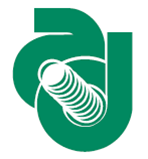Antonio Caciolli
(INFN - Padova)
Monitoring the environmental radioactivity has been found to be a fundamental tool in order to keep under control the effect of anthropic modifications of topsoil. It is also a good probe to understand the geological structure of ground surface, faster and extremely cheaper with respect other type of measurements. A light and compact detector for airborne ground radioactivity survey (AGRS) has been developed. The detector is composed by 4 x 4 liters of sodium iodide detectors and its signals are acquired in list mode to analyze offline the spectra in different time intervals down to 2 seconds. The radioisotope abundances are derived by using the full spectrum analysis (FSA) with the non negative least square (NNLS) implementation, which avoids possible artifacts in the spectrum due to not constrained χ2 minimization. The detector signals are collected together with the informations on altitude and vehicle position which are acquired every 2 seconds. A small NaI(Tl) placed on top of the main detectors monitors installation on ultralight vehicles which guarantees higher flexibility and cheaper costs. In addiction to the natural radionuclides ($^{40}$K, $^{238}$U, and $^{232}$Th) the setup is also calibrated to give the $^{137}$Cs activity which is actually not negligible after Chernobyl incident. The system has been already used successfully on a complete monitoring of the Elba Island surface. Maps are obtained combining the measured data with geological information by using collocated CoKriging.
Optional extended abstract
Monitoring the environmental radioactivity has been found to be a fundamental tool in order to keep under control the effect of anthropic modifications of topsoil. It is also a good probe to understand the geological structure of ground surface, faster and extremely cheaper with respect other type of measurements. A light and compact detector for airborne ground radioactivity survey (AGRS) has been developed. The detector is composed by 4 x 4 liters of sodium iodide detectors and its signals are acquired in list mode allowing to analyze offline the spectra in different time intervals down to 2 seconds spectra. The radioisotope abundances are derived by using the full spectrum analysis (FSA) with the non negative least square (NNLS) implementation, which avoids possible artifacts in the spectrum due to not constrained χ2 minimization. The detector signals are collected together with the informations on altitude (derived from temperature and pressure measurements), and vehicle position which are acquired every 2 seconds. The system is also provided by a small NaI(Tl) placed on top of the main detectors to count the contribution in the acquired signals from the radon in air. The weight of the system allows installation on ultralight vehicles which guarantees higher flexibility and cheaper costs. The software can analyze the position and altitude parameters during the flight giving to the pi- lot the correct informations about the path he has to follow. In addiction to the natural radionuclides (40K, 238U, and 232Th) the setup is also calibrated to give the 137Cs activity which is actually not negligible after Chernobyl incident. The system has been already used successfully on a complete monitoring of the Elba Island surface. The flight was performed at an average altitude of 100 m, which correspond to a 500 m diameter area per spot, and the concentration data were combined with the geological informations by using Collocated CoKriging (CCK) interpolator. The resulting maps of radionuclides abundances will be presented and discussed.
Antonio Caciolli
(INFN - Padova)
Dr
Alessandro Zanon
(INFN LNL)
Dr
Carlo Broggini
(INFN Padova)
Prof.
Carlos Rossi Alvarez
(INFN Padova)
Dr
Enrico Guastaldi
(CGT San Giovanni Valdarno, Univ. Siena)
Dr
Fabio Mantovani
(Università e INFN di Ferrara)
Dr
Gerti Xhixha
(Università e INFN Ferrara)
Prof.
Gian Paolo Buso
(INFN Legnaro)
Dr
Gian Piero Bezzon
(INFN LEgnaro)
Prof.
Giovanni Fiorentini
(Università di Ferrara, INFN Ferrara, INFN LNL)
Dr
Giovanni Massa
(CGT San Giovanni Valdarno, Univ. Siena)
Dr
Ivan Callegari
(CGT San Giovanni Valdarno, Univ. Siena)
Ms
Liliana Mou
(INFN LNL)
Ms
Marika Baldoncini
(Università di Ferrara)
Dr
Roberto Menegazzo
(INFN Padova)
Dr
Tommaso Colonna
(CGT San Giovanni Valdarno, Univ. Siena)

